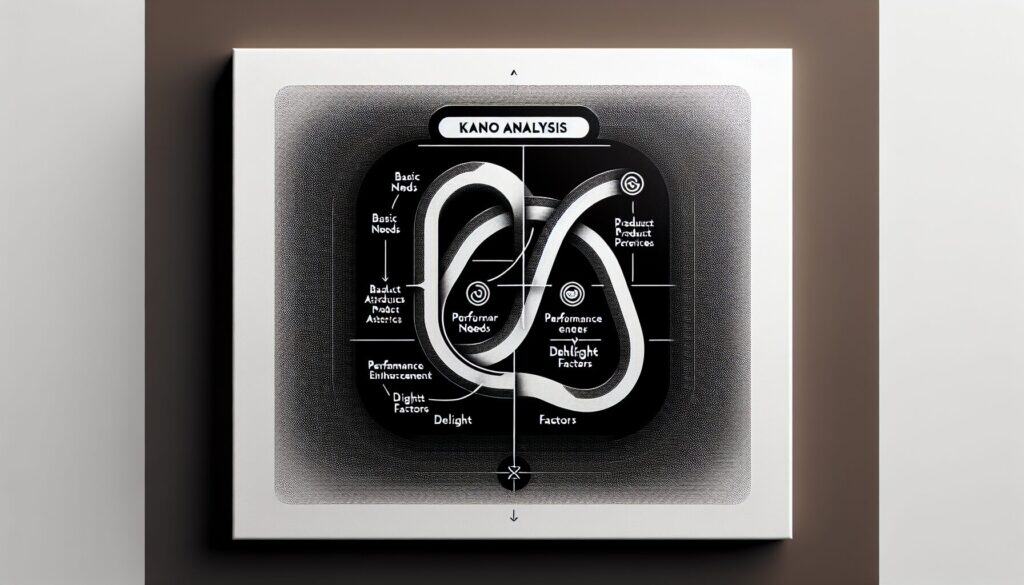To identify and categorize customer preferences for product features, distinguishing between those that satisfy basic needs, enhance performance, or delight customers.
- Methodologies: Customers & Marketing, Ideation, Product Design
Kano Analysis (Kano Model)

Kano Analysis (Kano Model)
- Customer Experience, Customer Journey Mapping, Design Thinking, Innovation, Product Development, Product Management, Quality Function Deployment (QFD), User experience (UX), Value Proposition
Objective:
How it’s used:
- Customers are surveyed using a specific pair of questions (functional and dysfunctional forms) for each feature. Responses are then mapped to categories: Must-be, Performance, Attractive (Delighters), Indifferent, and Reverse qualities.
Pros
- Helps prioritize feature development based on customer impact, identifies unspoken customer needs (delighters), avoids over-investing in features with low impact, provides a framework for understanding customer satisfaction dynamics.
Cons
- Requires careful survey design and administration, data analysis can be complex, customer preferences can change over time, interpretation of results needs context and can be subjective.
Categories:
- Customers & Marketing, Ideation, Product Design, Quality
Best for:
- Prioritizing product features, understanding customer expectations, and identifying opportunities for innovation by focusing on attributes that drive customer satisfaction and delight.
Kano Analysis is particularly advantageous during the early phases of product development, where understanding customer preferences can significantly influence design decisions and resource allocation. Industries such as technology, automotive, consumer electronics, and healthcare frequently apply this methodology to gauge how different features align with user expectations. Participation typically involves cross-functional teams, including designers, engineers, marketing specialists, and customer service representatives, who collaborate to gather and interpret customer feedback. The insights derived from the Kano Model allow teams to identify which features are standard essentials, such as battery life in electronics, which must be met to avoid dissatisfaction, and which features can delight users, like innovative user interfaces or unique aesthetic finishes that exceed basic expectations. This proactive approach can lead to strategic innovations that may not have been initially considered, as it reveals latent customer desires that can set a product apart from competitors. Furthermore, organizations can avoid misallocation of resources by recognizing features classified as indifferent or reverse qualities, thereby ensuring that investment in product development is concentrated on attributes that truly enhance user satisfaction. As research is conducted, methodologies like surveys can be utilized effectively to segment customer responses, providing granular insights that lay the groundwork for iterative product refinements.
Key steps of this methodology
- Develop a list of product features or attributes for evaluation.
- Formulate pairs of questions for each feature in both functional and dysfunctional formats.
- Administer the survey to customers, collecting their responses.
- Analyze customer responses by mapping them to the Kano categories: Must-be, Performance, Attractive, Indifferent, and Reverse.
- Prioritize features based on their categorization and customer impact.
- Identify opportunities for innovation and improvements through the analysis of delighters.
- Review and adjust product development strategies based on the Kano model results.
Pro Tips
- Incorporate qualitative data from customer interviews to enrich quantitative survey results, revealing deeper motivations behind preferences.
- Regularly iterate on the Kano analysis as market dynamics change, ensuring alignment with shifting customer expectations and competitive trends.
- Utilize cross-functional collaboration in interpreting Kano results to integrate diverse perspectives and uncover innovative solutions that resonate with users.
To read and compare several methodologies, we recommend the
> Extensive Methodologies Repository <
together with the 400+ other methodologies.
Your comments on this methodology or additional info are welcome on the comment section below ↓ , so as any engineering-related ideas or links.
Historical Context
1960
1980
1983
1990
1995
2000
2010
1950
1980
1980
1986
1994
1995
2000
(if date is unknown or not relevant, e.g. "fluid mechanics", a rounded estimation of its notable emergence is provided)














Related Posts
Manufacturing Operations Management (MOM)
Manufacturing Execution System (MES)
Manufacturing Control Plan
Manual Testing
Manual Handling Assessment Charts (MAC)
ManTRA (Manual Tasks Risk Assessment Tool)